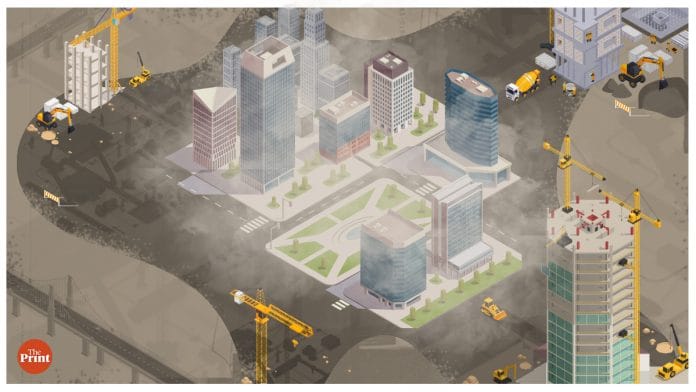For decades, the National Capital Region (comprising Delhi and satellite towns like Gurugram and Noida) has been the construction capital of the country. The last 15 years have seen one of the world’s big airports being built in stages, along with a vast metro network. Housing as well as office towers have come up in the satellite towns, with connecting expressways and metro links. Meanwhile, rules for higher floor-area ratios have facilitated the conversion of existing single residences into multi-storey apartment blocks.
Given the resulting increase in density, new flyovers and an overhead cross-city freeway have failed to cope with the increase in population and traffic, even as the city (devoted more than any other to personalised transport) chokes on its foul air.
Now it is Mumbai’s turn.
The financial capital has overtaken Delhi with the scale of its belated infrastructure build-up and a parallel boom in real estate construction. Almost anywhere you go in the city, giant construction equipment can be seen moving massive mounds of earth, pylons enclosed in scaffolding to support metro lines and overhead roads, plus excavation for tunnels that will cut under the city in different directions. The price is air pollution kicked up by the construction work, pollution that on some days has been worse than Delhi’s.
The promise is that all this will transform a city traditionally short of basic transport infrastructure.
Three metro lines now function in the suburbs, longer stretches are under construction. There is a massive coastal road project with dedicated bus lanes, to by-pass existing traffic corridors and carry four times the traffic of the existing, short sea link; a 22-km trans-harbour link over the water from midtown Mumbai to the mainland nearing completion; a new airport under construction; overhead connector roads to link the east and west of the city; and multi-kilometre tunnels under the city as well as the sea.
Construction work is on at a furious pace as most of these projects are slated for completion in the next couple of years. The only thing not being expanded, it would seem, is the suburban rail network that is the city’s lifeline.
The scale of the construction dwarfs earlier projects, like the Worli-Bandra sea link, the Bandra-Kurla financial district and the original Backbay reclamation that created the business district of Nariman Point. Separate from the transport projects, the extent of real estate construction (said to be 150 million square feet) has been assessed as being five times Nariman Point. The coastal road involves reclaiming much more land from the sea than before.
As Mumbai embarks on this ambitious journey, it is essential to consider the lessons learned from other cities. For instance, the challenges faced in Pune highlight the importance of synchronized urban planning and infrastructure development. The ongoing discussions around infrastructure development in Pune serve as a reminder of the potential pitfalls that can arise when growth outpaces planning.
The transport projects will provide new north-south corridors and east-west connections by rail and road, and link the island city to the mainland, and from there to the new airport and the Nhava-Sheva port.
In a couple of years, the city should be easier to move around in. But as has been the experience with Bengaluru and Delhi, as also with Mumbai’s mid-town redevelopment of textile mill land, new transport infrastructure rarely copes with growing needs.
That’s because the supply of transport links creates traffic, with better connections integrating the city and the mainland, just as Gurugram and Noida combine with Delhi to make a vast urban sprawl.
In Mumbai’s case, better ties to the mainland will help break out of the land scarcity that has constrained its growth. Equally, the sudden spurt in clearances for residential and office construction could mean population growth in an already crowded city that will also see the redevelopment of the Dharavi slum. Water supply and waste disposal will become even bigger issues.
This may be only the beginning. Delhi has just seen the inauguration of a high-speed rail line to Meerut, 65 km away; more lines are planned in other directions, to places like Alwar.
Commuters already shuttle between Mumbai, Thane and Navi Mumbai. Imagine a further outreach with faster transport links. In time we might see the Indian equivalent of the Greater Bay area of southern China, incorporating cities like Shenzhen and Guangzhou, plus Hong Kong: 70 million people accounting for 12 percent of China’s GDP. Time to plan ahead for better outcomes than we have seen so far in India’s cities?
By special arrangement with Business Standard.
Also read: Olympics are a ‘coming out party’ for countries on a per capita high. India’s a strong bet for 2036






